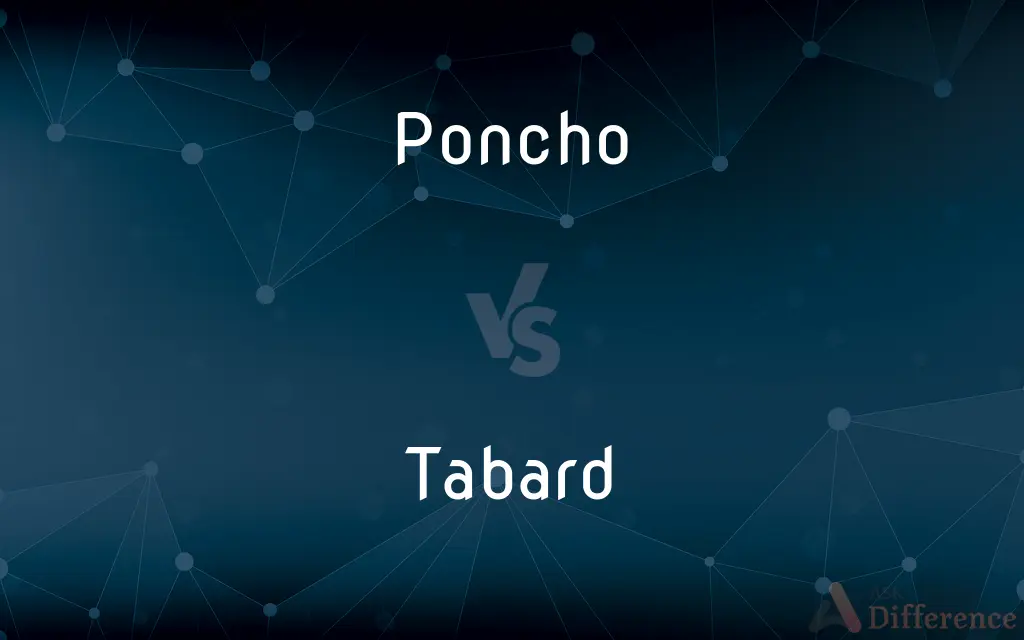Poncho vs. Tabard — What's the Difference?
Edited by Tayyaba Rehman — By Maham Liaqat — Updated on April 16, 2024
Ponchos are simple garments with a hole for the head, providing rain protection, while tabards are sleeveless, open-sided garments worn historically for identification.

Difference Between Poncho and Tabard
Table of Contents
ADVERTISEMENT
Key Differences
A poncho is primarily a protective outer garment designed with a central head opening and draped loosely over the body, offering easy movement and quick donning during rainy weather. On the other hand, a tabard is a heraldic garment, traditionally sleeveless and open on the sides, commonly used to display a coat of arms or other insignia, especially during medieval times.
Ponchos are typically made from waterproof materials and are often used as rainwear. They can come in various materials like wool, acrylic, or polyester. Whereas, tabards are generally made from lighter fabrics such as cotton, linen, or polyester blends and are less about protection from the elements and more about functionality and identification in settings like hospitality or events.
In modern fashion, ponchos have evolved into stylish accessories for both rain protection and warmth, available in numerous designs and colors. Conversely, tabards are used in more practical applications, such as uniforms in pubs, cafes, and historical reenactments, maintaining a more functional than fashionable role.
In terms of cultural significance, the poncho has deep roots in the traditional dress of the Andes region of South America, symbolizing heritage and artisan craft. In contrast, the tabard carries historical significance primarily in European contexts, often associated with medieval knights and squires.
Comparison Chart
Primary Use
Rain protection and warmth
Identification and uniformity in specific roles
ADVERTISEMENT
Design
Hole for the head, loose fitting, no sleeves
Sleeveless, open sides, may have a front and back panel
Material
Waterproof materials, wool, acrylic
Cotton, linen, polyester blends
Fashion vs. Function
Fashionable and functional in modern uses
More functional, less fashionable except in historical reenactments
Cultural Significance
Traditional garment in South America
Associated with European medieval history
Compare with Definitions
Poncho
An adaptable fashion item available in various materials.
Her cashmere poncho was perfect for the chilly evening.
Tabard
Associated with historical reenactments and medieval times.
At the fair, participants wore tabards over their costumes to add authenticity.
Poncho
A draped outerwear often used in wet weather.
The poncho she chose was adorned with traditional Andean patterns.
Tabard
Utilized as a uniform in various service industries.
All the staff at the event wore navy blue tabards.
Poncho
A garment typically made of waterproof material with a hole for the head.
He wore a bright yellow poncho to stay dry during the hike.
Tabard
A sleeveless garment worn over clothing, open at the sides.
The volunteers wore red tabards for easy identification.
Poncho
Symbol of cultural identity in regions like the Andes.
Each poncho at the market was unique, reflecting the weaver's personal style.
Tabard
Typically made from light fabrics such as linen or polyester.
His linen tabard kept him cool in the kitchen.
Poncho
A poncho (Spanish pronunciation: [ˈpontʃo]; Quechua: punchu; Mapudungun: pontro; "blanket", "woolen fabric") is an outer garment designed to keep the body warm. A rain poncho is made from a watertight material designed to keep the body dry from the rain.
Tabard
Historically used to display a coat of arms.
The knight's tabard was emblazoned with his family's crest.
Poncho
A blanketlike cloak having a hole in the center for the head.
Tabard
A tabard is a type of short coat that was commonly worn by men during the late Middle Ages and early modern period in Europe. Generally worn outdoors, the coat was either sleeveless or had short sleeves or shoulder pieces.
Poncho
A similar garment having a hood used as a raincoat.
Tabard
A short, heavy cape of coarse cloth formerly worn outdoors.
Poncho
A simple garment, made from a rectangle of cloth, with a slit in the middle for the head.
Tabard
A tunic or capelike garment worn by a knight over his armor and emblazoned with his coat of arms.
Poncho
A similar waterproof garment, today typically of rubber with a hood.
Tabard
A similar garment worn by a herald and bearing his lord's coat of arms.
Poncho
A kind of cloak worn by the Spanish Americans, having the form of a blanket, with a slit in the middle for the head to pass through. A kind of poncho made of rubber or painted cloth is used by the mounted troops in the United States service.
Tabard
An embroidered pennant attached to a trumpet.
Poncho
A trade name for camlets, or stout worsteds.
Tabard
A silk banner attached to a bugle or trumpet.
Poncho
A blanket-like cloak with a hole in the center for the head
Tabard
A sleeveless jerkin or loose overgarment.
Tabard
(historical) A sleeveless garment made of coarse cloth formerly worn outdoors by the common people.
Tabard
(historical) A cape or tunic worn by a knight, emblazoned with the coat of arms of his king or queen on the front.
Tabard
(historical) A similar garment officially worn by a herald and emblazoned with his sovereign's coat of arms.
Tabard
A sort of tunic or mantle formerly worn for protection from the weather. When worn over the armor it was commonly emblazoned with the arms of the wearer, and from this the name was given to the garment adopted for heralds.
In a tabard he [the Plowman] rode upon a mare.
Tabard
A short sleeveless outer tunic emblazoned with a coat of arms; worn by a knight over his armor or by a herald
Common Curiosities
Are tabards suitable for outdoor activities?
Tabards are more suited to indoor use or light outdoor activities where heavy protection isn't necessary.
What is a poncho used for?
Ponchos are used for rain protection and as fashionable outerwear in various climates.
Can ponchos be used in formal settings?
While traditionally casual, modern designs can be appropriate for more formal occasions.
Can anyone wear a poncho?
Yes, ponchos are generally designed to be unisex and one-size-fits-all.
What materials are ponchos made from?
Ponchos can be made from waterproof materials, wool, or synthetics like polyester.
How do modern tabards differ from historical ones?
Modern tabards are more about functionality in specific roles, whereas historical ones were significant in heraldry.
What is a tabard typically used for?
Tabards are used for identification and uniform purposes in services and historical reenactments.
Do ponchos come in different sizes?
Ponchos are usually one-size-fits-all but may vary in length and material thickness.
What is the historical significance of a tabard?
Tabards have a rich history in Europe, especially during the medieval period for identifying knights.
What accessories complement a poncho?
Scarves, hats, and gloves can complement a poncho well, especially in colder weather.
What are the main differences between ponchos and tabards?
Ponchos offer more coverage and protection, while tabards are more about identification.
Are ponchos and tabards interchangeable?
No, they serve different purposes and are distinct in their design and use.
Are tabards part of modern fashion?
Tabards are rarely seen in mainstream fashion and are typically used in specific service industries.
How should a tabard fit?
A tabard should fit comfortably, allowing for movement without being too loose.
How do you choose a poncho?
Consider the material, weather suitability, and personal style preferences when choosing a poncho.
Share Your Discovery

Previous Comparison
Entrance vs. Opening
Next Comparison
Meeting vs. PartingAuthor Spotlight
Written by
Maham LiaqatEdited by
Tayyaba RehmanTayyaba Rehman is a distinguished writer, currently serving as a primary contributor to askdifference.com. As a researcher in semantics and etymology, Tayyaba's passion for the complexity of languages and their distinctions has found a perfect home on the platform. Tayyaba delves into the intricacies of language, distinguishing between commonly confused words and phrases, thereby providing clarity for readers worldwide.














































